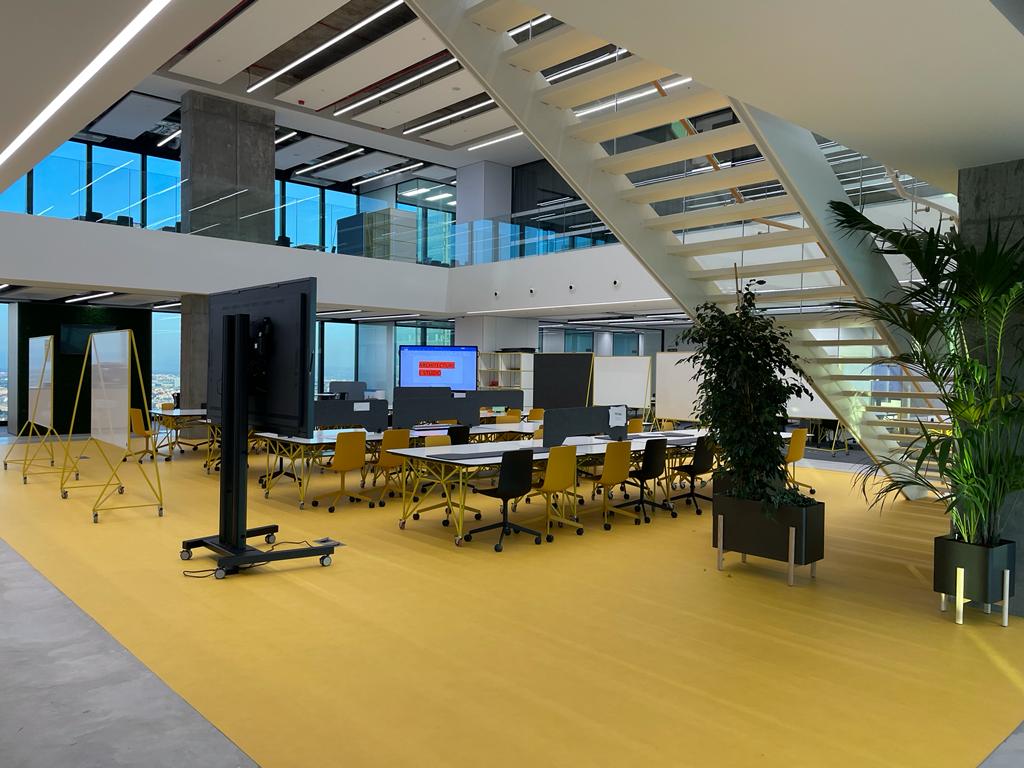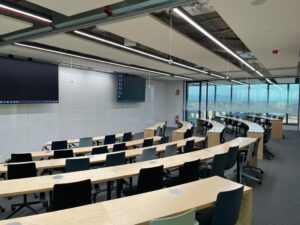
ONE of the tallest skyscrapers in Spain which has received more than three million visitors has been denoted as having excelled in its sustainable design after installing a globally proven KNX building automation system.
Caleido Tower is a 181-metre (594ft) high, 36-story tower in Madrid, and the seventh tallest building in Spain. The building has met (Leadership in Energy and Environmental Design (LEED) certification – a framework which consists of various rating systems tailored to different types of buildings, spaces, and communities to assessing the sustainability of a project.
Caleido Tower achieved GOLD which means it ‘serves as exemplary models of sustainability, showcasing the potential for significant environmental impact reduction through thoughtful design and operation’.
The building achieved this by using natural light with the help of an advanced lighting control system by German manufacturer B.E.G. – whose UK headquarters is based in Surrey. Caleido Tower also has facial recognition, intelligently controlled lifts and air filtration and ventilation systems are incorporated.
It is expected that more than three million visitors will visit the 70,000 sqm Caleido complex annually. The project, in the shape of an inverted T, has been divided into four areas: an educational area with 35 floors used by a business school, a wellness clinic, an underground car park, and restaurants and shops.
The technology protocol used in the Caleido Tower was KNX, a globally proven bus system within building automation, which brings together multiple systems enabling the uniform networking and visualisation of intelligent devices.
B.E.G. predominately used the PICO sensor – one of the smallest KNX detectors in the world – for this project due to its size. Despite its diameter of only 33 mm, it has a range for motion detection of 10m transversely, 6m frontally and 4m for seated activities. This means that it detects even the smallest movements, such as the operation of a computer mouse.
In addition to a light output (controllable or switchable) and a slave output for extending the detection range, the B.E.G. PICO also has three HVAC outputs with which energy-intensive systems such as air-conditioning units can be controlled. The light output can be used both as an occupancy detector and as a twilight detector (motion-independent control/switching).

The B.E.G. PICO also has functions such as a temperature sensor, presence simulation, corridor function, orientation light function, short presence and self-adjustment of the follow-up time. The short presence, for example, can save additional energy as the follow-up time is reduced to an adjustable percentage if a room is only entered briefly to fetch an item for example.
Paul Jones, Sales Director of UK & Ireland at B.E.G, said: “Since very large ceiling panels were used, it had to be ensured that the respective panel would not sag over time due to the weight of a detector. Weighing only 14g, the B.E.G. PICO proved ideal and was integrated in all rooms where detectors were planned.
With the help of BIM, the building was digitally modelled in advance – a planning method that is increasingly becoming the standard in the planning of large projects worldwide. In the process, all alphanumeric properties of the planned building are represented. This data is automatically kept up-to-date and gives all parties involved access to the status of the project to ensure the different service combine effectively.
The combination of bus systems can help to save energy costs. In the Caleido Tower, over 15,000 DALI luminaires were installed in addition to KNX, while a gateway was used to control these with KNX. This connected the KNX bus with the DALI bus designed for lighting control.
Each B.E.G. gateway was able to switch and dim up to 64 ECGs in 16 groups, while scene control of individual ECGs is also possible. In addition to RGB and Tuneable White, the gateway also supported DALI-LINK multi-sensors.
In the corridors of the tower, the light is controlled by the B.E.G. PICO depending on daylight and presence. If no more movement is detected, the orientation light switches on. The lighting is dimmed down to a value of 10 percent as soon as the room is no longer occupied.
This state remains permanently until the next movement, or the light is switched off after a preset time without detecting movement again. A calendar function can also be used to implement a night mode.
Especially in large projects such as the Caleido Tower, an orientation light is often used to visually illuminate the building. The lighting of the IE logo on the facade is automatically switched on in the evening by the B.E.G. KNX switching actuator with a calendar function. Individual luminaires are also switched on and off with switching actuators. This is achieved for example, when illuminating screens for presentations.
With the calendar function, the light is automatically switched off at a preset time in the evenings when there are no more classes and, in addition, no movement is detected in the surrounding areas. This affects the refectory, for example, where the B.E.G. PICO only functions as a twilight detector and only regulates the light to the desired brightness depending on the natural daylight.”
The IE Business School was opened in the Caleido Tower in October 2021 in the presence of Felipe VI, King of Spain, and António Guterres, Secretary General of the United Nations.












